Way Out West In Japan
A Trip through the Westernmost Railway Station on Matsuura Railway in Kyushu
By W. A. Pearce
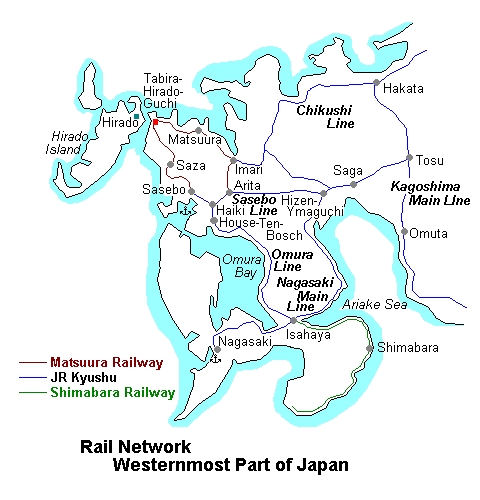 During the course of a visit to Japan
in April and May of 1996, I was one of a group which spent a few days
at Nagasaki, in Kyushu, which town has an interesting tramway system,
and which can also be used as a base for railway journeys to various
places in the western part of the island.
During the course of a visit to Japan
in April and May of 1996, I was one of a group which spent a few days
at Nagasaki, in Kyushu, which town has an interesting tramway system,
and which can also be used as a base for railway journeys to various
places in the western part of the island.
Consulting the maps in the current JTB timetable book, a round trip
that looked interesting was one from Nagasaki through Sasebo, along the
Matsuura Line through the town of that name, then back inland via Imari
and Arita on the Sasebo Line, thence to the Nagasaki Main Line, and so
finally back to Nagasaki. From the timetables it was obvious that this
would be an easy day trip, so I decided to make this journey on the
next day, Sunday 26th. of May.
This day dawned bright and sunny, and after breakfasting at Nagasaki
station, I boarded the 0845 'Seaside Liner', a four car DMU set bound
for Sasebo. An on-time departure saw the train set off along the
Nagasaki Main line to the junction station of Isahaya, here it turned
northwards onto the Omura Line, which initially runs through hilly
country. Leaving the hills, the line heads towards the sea and is soon
running along the edge of the waters of Omura-wan. Pleasant views of
the ocean were enjoyed along this section.
Emerging from one of the several tunnels, to seawards there appeared
an amazing collection of European buildings in the style of the 18th.
century, this is the Dutch themed resort and pleasure park, 'Huis ten
Bosch' (Dutch for House in the Forest), which I looked at the next day,
and although not having anything in the way of railway or tramway
interest, was definitely worth visiting.
The next main station was Haiki, a junction where the electrified
Sasebo line comes in. This electrification extends along the Omura line
to Huis ten Bosch, and EMU trains run directly to this resort from
Hakata and other places. At Haiki I noticed a train of blue sleeping
cars carrying the destination sign 'Kyoto', this train had probably
been an over-night service from that city to Sasebo or Huis ten Bosch,
and was now stabled at Haiki before forming the return working that
evening.
Arrival at Sasebo was at 1030. This town has an excellent harbour
and here can be found the long-established Sasebo Naval Base, still an
important part of Japan's Self Defence organisation.
Alighting from the 'Seaside Liner', here in a short bay platform I
found a single diesel railcar, in a livery of white with blue, red and
orange stripes, marked with the letters 'MR', these initials standing
for Matsuura Railway. This is a 'third-sector railway' operating over
what had been the Matsuura Line of the JR, this meant that I could not
use my JR Railpass to travel on it.
The MR DRC was due to depart at 1101, so after a quick look at the
timetable I bought a ticket, costing Y1,120, to take me to the DRC's
destination, Tabirahiradoguchi, about half-way along the line. With an
arrival time at that place of about half-past twelve, I thought that
this would be a place to get a mid-day meal, (but the best laid
plans...!).
As departure time approached I took my seat in the DRC, right at the
front where one would get a good view of the line ahead. On the dot the
driver (this car was one-man operation), opened the throttle and we
moved off, directly onto a 1:33 rising grade. This single track line
heads inland from Sasebo, climbing into the surrounding hills with
steep grades and many short tunnels, giving a pleasantly scenic run.
Having negotiated the hills the line turns towards the seacoast and
after passing the fair sized town of Motoyama the countryside becomes
more open and the line flattens out. This service was an all-stations
one, many of the places at which it stopped were only tiny halts, it
had a fair patronage of school children, shoppers and the like.
A longer stop was made at the town of Saza, here we crossed a Sasebo
bound JR 'Seaside Liner', but where this service originated from I
could not tell. Saza was left just before noon, from here the line once
more enters the hills. Speeds of course are not high, observing the
speedometer in the driver's cab it was not often seen to go above 60
km/hr.
The line turns westwards once more, and then, just after 1230 we
arrived at Tabirahiradoguchi, where this service terminated. This town
is on the coast, and out to sea is the large island Hirado-shima, which
is apparently a popular resort place, connected to the mainland by a
road bridge. The name Tabirahiradoguchi can be rendered in English as
'Tabira, entrance to Hirado'.
I had planned to eat at Tabirahiradoguchi, but this station turned
out to be one of the few Japanese railway stations that I have come
across that was poorly served with food selling facilities, even the
normally ubiquitous vending machines were scarce. Such restaurants
found outside the station were all closed, but I finally discovered a
small pastry shop open, so my lunch comprised some bread rolls from
there and a can of soft drink and an ice cream from nearby vending
machines.
However, outside the station I found a large signboard, carrying
some interesting information. This of course was all in Japanese, but I
was able to work out that this sign said that Tabirahiradoguchi was the
westernmost railway station in all Japan. Amongst the information given
were distances to Seoul and New York, the latitude and longitude of
Tabirahiradoguchi, and the most distant stations at the other cardinal
points of the compass. These are: North, Wakkanai; East, Higashi
Nemuro, both of which are in Hokkaido, and South, Nishi Oyama in Kyushu.
The next part of this journey , still on the Matsuura Railway,
would take me eastwards along the Japan Sea coast and then back inland.
Another ticket was bought for Y1,320, this would get me to the end of
the MR at Arita, on the JR Sasebo Line. The single DRC for this
section, which had come through from Sasebo, was due to depart at 1304.
On arrival I boarded it, and off we went, travelling through rolling
hills, a little inland from the sea. Not long after leaving
Tabirahiradoguchi we passed a huge industrial plant, probably
manufacturing cement, a somewhat unexpected sight in what had been
generally a rural landscape.
The main town along this part of the line is Matsuura, the stop here
was at about 1330. The ocean can occasionally be glimpsed from the
railway as we headed south-east alongside a narrow inlet of the sea. At
about 1416 we arrived at Imari, another fair-sized town, here the DRC
terminated and a quick change was made to another single DRC for the
final part of the journey on the Matsuuda Railway. Imari is also the
terminus for the JR Chikuhi Line, which comes in from the east.
Departure from Imari was at 1419, this DRC was of a design with end
corridor connections, obviously to allow the use of a trailer car or
another DRC in multiple. This line climbs a ridge and then drops down
through wide valleys to a flatter area. Arrival at Arita was at 1445,
and here I said farewell to the Matsuuda Railway. Two options presented
themselves to me at Arita. I could either go westwards to Haiki on the
Omura Line and from there return to Nagasaki by the same route that I
had used in the morning, or go east to the Nagasaki Main Line. As there
was still plenty of time left in the day, I decided to take the eastern
option. Also as myself and another member of the party were to go from
Nagasaki to Kumamoto in a couple of days time I thought that it would
also be wise to go back along the Nagasaki Main line to Tosu, the
junction for the Kagoshima Main Line, there to check from which
platform the Kumamoto train left, as the connection time there was a
bit tight.
Arita station was being re-built, this meant that there was no kiosk
operating and only a couple of drink vending machines were available,
so once again I was frustrated in my search for a snack!
At 1509 a Hakata bound Limited Express arrived, this I boarded and
travelled on to Tosu, a run of about one hour. On arrival there I
checked on the appropriate platforms, No.3 from Sasebo and Nagasaki,
No.6 to Kumamoto, so a direct cross-platform interchange would not be
possible, something worth knowing.
At Tosu I had a wait of about three-quarters of an hour for the
Nagasaki train, this when it arrives was a 'Hyper-Saloon Express',
quite full, with standing room only, however I still got on, and on
arrival at Saga, the next stop, 15 minutes later, many passengers
alighted, so I was able to obtain a seat for the remainder of the trip
back to Nagasaki, where I arrived at 1830. Here the station restaurants
were still open, so I was able to have a good meal before returning to
my hotel.
On this day I had travelled over the full length of the Matsuura
Railway, unexpectedly found the westernmost railway station in Japan,
and journeyed along part of the Sasebo Line, all in fine weather
through pleasant scenery, certainly a very interesting and worthwhile
trip.
The total distance travelled, including the diversion up to Tosu
and back was about 373 km, total journey time 9 hours and 45 minutes,
and on the 93.8km of the Matsuura Railway there were 53 stations and
halts, all of which we stopped at.
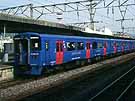
'Seaside Liner', Four car set of 200C series diesel rail cars at Sasebo.
|
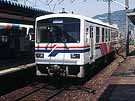
Matsuura Railway DRC MR202 at Sasebo station.
|
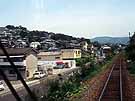
View forwards from MR202 enroute for Saza, note gradient board, 25 per mille (1:40).
|
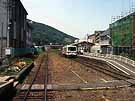
Crossing MR railcar at Hidariishi.
|

Stop at Saza. Interior view of MR202, note changemaking m/c
(Silver cabinet on floor), Seiriken ticket issuing m/c (small orange
box), Seiriken fare table panel above windscreen
|
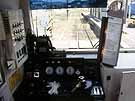
At Saza. View of driver's position of MR202. Note white
gloves, phone and radio at left, pocket watch and chain above brake
handle and timetable.
|
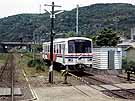
Crossing Sasebo bound DRC No.106 at Ainora.
|
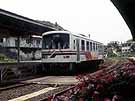
DRC M202 stands at Tabirahiradoguchi station
platform, forming the 1308 departure for Sasebo.
|
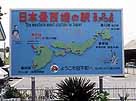
Notice board outside Tabirahiradoguchi station, explaining
that this is the westernmost railway station in Japan, at N lat. 33
deg. 21 min., 38 sec., E long. 129 deg., 35 min., 01 sec. From here,
Seoul in Korea is 542 km. away, and New York is 11,800 km. In Japan
itself, Hakata is distant 124 km., Osaka 780, Tokyo 1,336 and Sapporo
2,551.
|
[Home Page]
 During the course of a visit to Japan
in April and May of 1996, I was one of a group which spent a few days
at Nagasaki, in Kyushu, which town has an interesting tramway system,
and which can also be used as a base for railway journeys to various
places in the western part of the island.
During the course of a visit to Japan
in April and May of 1996, I was one of a group which spent a few days
at Nagasaki, in Kyushu, which town has an interesting tramway system,
and which can also be used as a base for railway journeys to various
places in the western part of the island.







